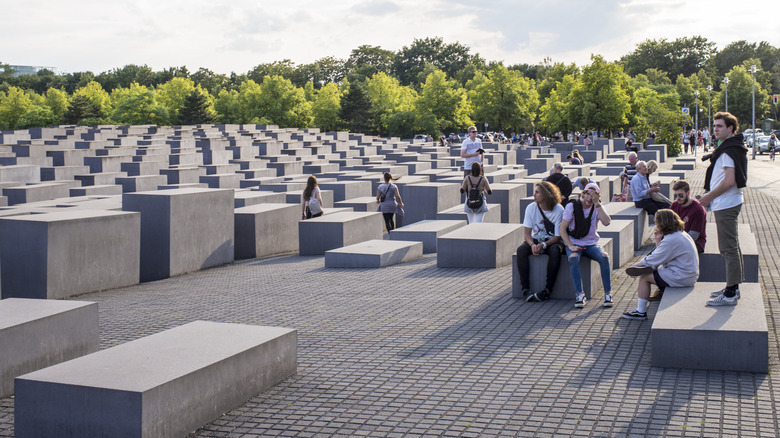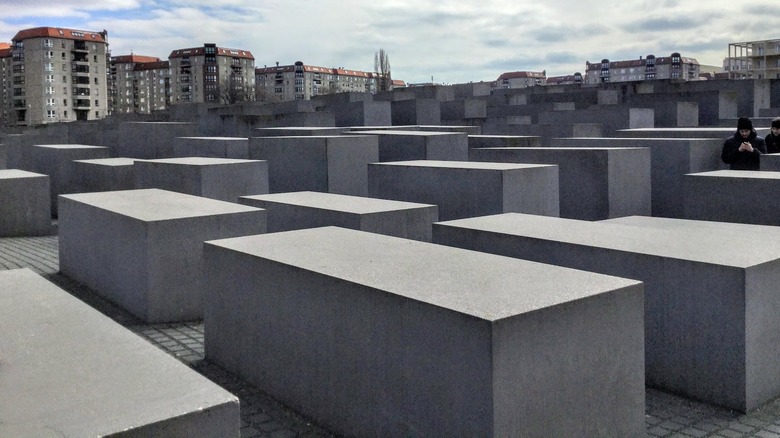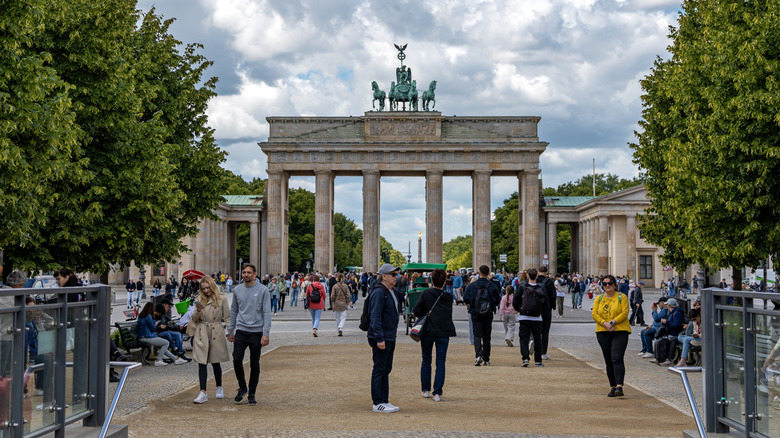The Important Unspoken Rule Tourists Should Know When Visiting Berlin's Holocaust Memorial
One of the most devastating events over the past few centuries was the Holocaust, the systematic oppression and genocide that occurred in Europe from 1933 to 1945. While many structures related to the Holocaust were destroyed, others, like the former Auschwitz and Dachau concentration camps, are still standing in order to educate future generations. Additionally, memorials to Holocaust victims are found throughout the continent. One of the biggest is the Memorial to the Murdered Jews of Europe, also known as the Holocaust Memorial in Berlin, a monument quietly demanding the utmost respect from visitors, often through compliance with various unspoken rules. Though it's a site worth remembering, many advise that capturing the experience in a personal photo shoot is one of those tacit taboos you should try to avoid.
Berlin's Holocaust Memorial is located near many of the city's famous landmarks, including Brandenburg Gate and the Reichstag Building, meaning tourists frequent this part of town. Tourists often have their cameras ready to capture memorable moments from their trips, but you should think twice before taking a selfie at the Holocaust Memorial. It may not be among the destinations around the world where taking selfies is banned, but a memorial to the 6 million people who died so horrifically might not be the place for these photos.
Not everyone agrees that selfies are inappropriate
The Holocaust Memorial in Berlin is unique in appearance, and what it represents is not made obvious upon first glance. It is made up of 2,711 gray concrete rectangles of varying heights. Walking between the rows is part of the experience, as the ground is uneven as well. The memorial has been met with mixed receptions since designer Peter Eisenman unveiled it in 2005. The unclear messaging regarding the purpose of these concrete slabs is perhaps why some feel that it is okay to take selfies here, but onlookers or viewers on social media who know the monument's significance might see it as disrespectful.
Interestingly enough, memorial spokesperson Felizitas Borzym seems to understand the different ways in which people connect with history. "To have photos of themselves in the location is really the way young people experience this memorial," Borzym told ABC News. Even still, she explained that taking selfies at the Holocaust Memorial shouldn't be done in a manner that is "a little too much in the direction of too flashy." Employees still definitely call out bad behavior when they see it.
Germans are not always keen to take selfies
Felizitas Borzym does not quite take a hard stance against selfies at Berlin's Holocaust Memorial, but other locations relating to this part of history have expanded on the topic. While social media can help a wide range of demographics learn about historical events and preserve the memories of people lost during such events, staff at the Auschwitz Memorial have also used social media to remind people not to turn their visit into a photoshoot. In other words, if you choose to post about your experiences at any sort of memorial or historical location, be sure to keep the focus on education and reflection.
While the jury might still be out on if it is okay to take selfies at the Holocaust Memorial or not, Berlin is a city where locals will probably get annoyed by people taking selfies. In general, Germans keep to themselves and enjoy their privacy. They don't often take selfies and perhaps don't want to appear in the background of a stranger's. The aversion may be unfamiliar to some, but abiding by local customs is one way you can help prevent Europe from becoming "anti-tourist." This is especially important as Europeans try to draw attention toward the negative effects of overwhelming numbers of tourists.


